Lalitpur
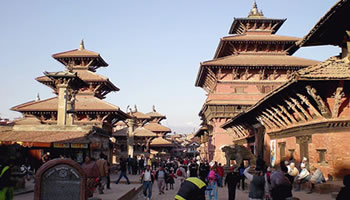 Lalitpur, famously known as Patan, is probably the oldest Buddhist City in the world. It is situated on a plateau just across the holy Bagmati River. It is designed and built after Buddhist Dharma Chakra. It is surrounded by 4 stupas, one at each corner of its cardinal points. These stupas are said to have been built by the famous Emperor Ashoka in the 3rd century BC. It is a charming city which has still retained its tranquil ambience. Walking down the quiet, narrow streets of the city, you would come across traditional buildings, exquisite temples and tiny shops of artists, metal-workers, wood-workers and stone-cutters. The city is indeed renowned for its fine craftsmanship. Lalitpur, famously known as Patan, is probably the oldest Buddhist City in the world. It is situated on a plateau just across the holy Bagmati River. It is designed and built after Buddhist Dharma Chakra. It is surrounded by 4 stupas, one at each corner of its cardinal points. These stupas are said to have been built by the famous Emperor Ashoka in the 3rd century BC. It is a charming city which has still retained its tranquil ambience. Walking down the quiet, narrow streets of the city, you would come across traditional buildings, exquisite temples and tiny shops of artists, metal-workers, wood-workers and stone-cutters. The city is indeed renowned for its fine craftsmanship.
Places to Visit:
Patan Durbar Square
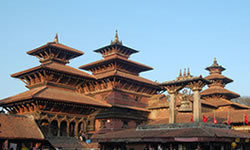 The Patan Durbar Square, situated in the heart of the city, consists of enchanting mélange of palace buildings, artistic courtyards and graceful pagoda temples. The former Royal Palace complex is the center of Patan's religious and social life and houses a museum containing an array of bronze statues and religious objects. The Square and its surroundings provide very good example of ancient Newari architecture. There are three main courtyards or chowks, named central Mul Chowk, Sundari Chowk and Keshav Narayan Chowk in the square. To the west of the complex, there are a dozen free standing temples of various sizes and styles. The Sundari Chowk with the sunken bath of Tusha Hiti, contains exquisite woodcarvings, stone, and metal sculpture. Patan Durbar Square also houses a temple of Taleju Bhawani. The Patan Durbar Square, situated in the heart of the city, consists of enchanting mélange of palace buildings, artistic courtyards and graceful pagoda temples. The former Royal Palace complex is the center of Patan's religious and social life and houses a museum containing an array of bronze statues and religious objects. The Square and its surroundings provide very good example of ancient Newari architecture. There are three main courtyards or chowks, named central Mul Chowk, Sundari Chowk and Keshav Narayan Chowk in the square. To the west of the complex, there are a dozen free standing temples of various sizes and styles. The Sundari Chowk with the sunken bath of Tusha Hiti, contains exquisite woodcarvings, stone, and metal sculpture. Patan Durbar Square also houses a temple of Taleju Bhawani.
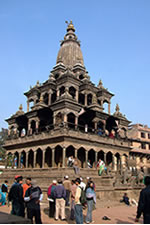 Krishna Mandir Krishna Mandir
Krishna Mandir is Nepali's finest piece of stone architecture. Siddhi Narsingh Malla, a passionate devotee of Krishna, built this temple in the 17th century when he dreamed Krishna and Radha being union at this spot. The characteristic feature of the temple is that no nails or wood have been used and the construction is entirely of stone. The first storey of the temple consists of scenes from the Hindu holy book Mahabharata; the second storey pavilions are band by friezes from the Ramayana. Atop a stone pillar in front, a brilliantly executed large metal Garuda (the bird on which Lord Krishna rides) kneels in homage.
Mahabouddha
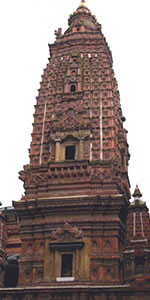 This Buddhist monument lies a little further east from the southern end of Darbar Square and then turning right at the sunken water taps. The temple, made of clay bricks with thousands of images of Lord Buddha engraved, is an excellent example of terracotta art form. The terracotta structure is one of the 14th century Nepalese architectural masterpieces. This Buddhist monument lies a little further east from the southern end of Darbar Square and then turning right at the sunken water taps. The temple, made of clay bricks with thousands of images of Lord Buddha engraved, is an excellent example of terracotta art form. The terracotta structure is one of the 14th century Nepalese architectural masterpieces.
Kwa Bahal "Golden Temple"
This Buddhist monastery is a three storey golden pagoda of Lokeshwor (Lord Buddha). The monastery, built in the 12th century by King Bhaskar Verma, is embellished with exceptionally fine woodcarvings and other artistic images are scattered around the courtyard. Inside the upper storey of the pagoda, 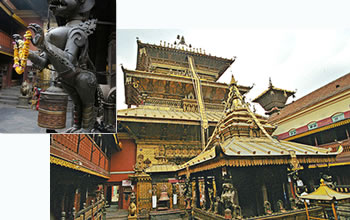 there are the golden images of Lord Buddha and a large prayer wheel. It is a five-minute walk west and north from the northern end of Durbar Square. there are the golden images of Lord Buddha and a large prayer wheel. It is a five-minute walk west and north from the northern end of Durbar Square.
Kumbheshwor
The five storey pagoda of Kumbheshwor is one of the oldest temples of Patan. The temple is dedicated to Lord Shiva. It was originally constructed in 1392 as a two storied shrine, but later in the 17th century Srinivasa Malla added the upper three tiers of the temple. Hence this is one of the Valley's two five storied temples (the other is Bhaktapur's Nyatpola). The two ponds here (Konti) are believed to be connected by a subterranean channel to the holy Gosainkunda Lake, which lies several days' walk north of Kathmandu. On the festival of Janai Poornima (usually the A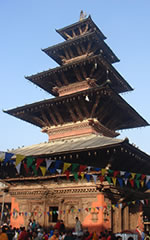 ugust full moon) thousands of devotees of Lord Shiva come to worship the embossed silver sheath worn by the temple's sacred Linga (phallic symbol), which is placed in a special pavilion in the middle of the tank in the hub of the temple. ugust full moon) thousands of devotees of Lord Shiva come to worship the embossed silver sheath worn by the temple's sacred Linga (phallic symbol), which is placed in a special pavilion in the middle of the tank in the hub of the temple.
On the southern side of the temple complex is the single storey shrine of goddess Bangalamukhi with green painted woodwork. The goddess Bangalamukhi is embodied in a tiny image beneath an elaborate silver corona and canopy of snakes. Bangalamukhi is considered as the wish-fulfilling goddess. Many devotees visit the temple with hopes that their wishes get rewarded and fulfilled by goddess Bangalamukhi at one point of their life. The temple is unusually crowded by many devotees on every Thursdays of the weeks.
The Ashokan Stupas
Emperor Ashoka of I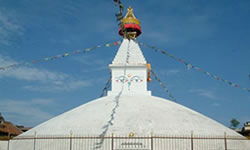 ndia visited Nepal in 250 B.C. and built four ancient stupas at the four corners of Patan. The four stupas are situated in Pulchowk, Lagankhel, Ebahi and in Teta (way to Sano Gaon) respectively. These stupas give evidence to the city's ancient religious importance. ndia visited Nepal in 250 B.C. and built four ancient stupas at the four corners of Patan. The four stupas are situated in Pulchowk, Lagankhel, Ebahi and in Teta (way to Sano Gaon) respectively. These stupas give evidence to the city's ancient religious importance.
Achheshwor Mahavihar
It was founded towards the beginning of the 17th century. The Mahavihar has recently been reconstructed and it commands a beautiful view of the Kathmandu Valley. It is located behind the Ashokan Stupa at Pulchowk.
Temple of Machhindranath and Minnath
T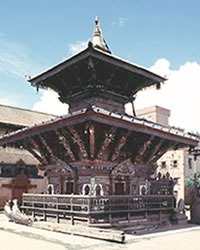 he pagoda of Red Machhindranath was built in 1408 A.D. and is situated in Tabahal. For 6 months the deity is taken to its other shrine in Bungamati. The temple of Minnath is situated in Tangal on the way to Tabahal. he pagoda of Red Machhindranath was built in 1408 A.D. and is situated in Tabahal. For 6 months the deity is taken to its other shrine in Bungamati. The temple of Minnath is situated in Tangal on the way to Tabahal.
Tibetan Refugee Camp
The camp was established in 1960 A.D. under the initiative of the International Red Cross and the Swiss Development Corporation (SDC), in cooperation with His Majesty's Government of Nepal. Its main objective is to help the Tibetan refugees to do something productive and support themselves. You can purchase beautiful Tibetan Carpets in this camp.
The Central Zoo
Situated at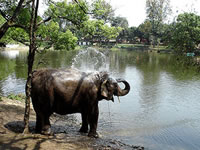 Jawalakhel, the zoo has many animals, birds and reptiles in its collections mostly representing the Himalayan fauna. There is a beautiful pond built in 17th A.D. One can go for boating in this pond. It opens daily except Mondays from 10.00 am to 4.00 pm. Jawalakhel, the zoo has many animals, birds and reptiles in its collections mostly representing the Himalayan fauna. There is a beautiful pond built in 17th A.D. One can go for boating in this pond. It opens daily except Mondays from 10.00 am to 4.00 pm.
National Library
It is located at Harihar Bhawan in Pulchowk, Patan. The Library contains about 70,000 books, most of which is in English with remaining rest in Sanskrit, Nepali, Hindi and Nepal Bhasha. The library preserves some rare scholarly books in Sanskrit and English dating from the 17th century.
|